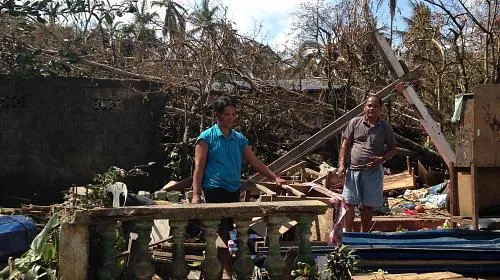“We were all terrified that we were about to relive Haiyan. But this time we were prepared, and so was my home,” said Erna Celis, a mother of three whose home was completely destroyed by Haiyan but was spared by Typhoon Hagupit.
Before Typhoon Haiyan, many people did not prepare. They thought it was just like any other storm they commonly get in the Philippines. But after shockingly claiming nearly 7,000 lives and leaving four million homeless, they learned how unpredictable storms can be.
Typhoon Hagupit was different. As warnings of the typhoon surfaced, many people began preparing days before it was forecast to hit with preparations such as stockpiling food, packing their valuables in plastic, reinforcing their roofs and seeking refuge in an evacuation centers.
Good preparation may have saved hundreds of lives and thousands of homes as Typhoon Ruby ripped through the Philippines.
Erna and her family reside in Katipunan, a village just outside Tacloban, and evacuated to the nearby school. As the typhoon crawled through the Philippines, they feared for their lives as the wind howled and battered against the building throughout the night.
“This typhoon was not as strong as Haiyan but it lasted much longer. No one slept at all, as the winds were extremely loud all night long. I was afraid of what I would find left of our village as the sun came up the next morning, but luckily my house was still standing,” Erna shared.
Not only was Erna’s house salvaged, but it did not experience any damage at all, nor did any of the homes in Katipunan. After Haiyan had flattened 90% of the village, the people of Katipunan learned from CARE how to rebuild their homes stronger and safer, and how to better prepare for the next disaster.
“Our goal after Haiyan was to help people rebuild homes that could survive the next typhoon, and that’s exactly what happened with Typhoon Hagupit. With the Philippines being a country prone to disasters, we want to help the people build back not just better, but safer,” said CARE shelter engineer Janize Llantino.
But not everyone in the Philippines was as prepared for Hagupit as the people of Katipunan were. The island of Samar bore the brunt of the damage from the typhoon. Thousands of homes along the coast were destroyed or partially damaged.
Rizza and Julio Cui were one of the unfortunate families in Eastern Samar who lost their home. They made a living buying and selling fish in the market, but the typhoon has temporarily disrupted the fishing market leaving them with no income.
“I want to rebuild my home, but I’m not sure when and how that will happen since I’m unable to earn any income right now,” said Rizza.
As CARE responds to the damage from Typhoon Hagupit, it is planning to replicate its successful Build Back Safer program for vulnerable families like Rizza and Julio, so that, like Erna they are prepared when the next typhoon strikes.

